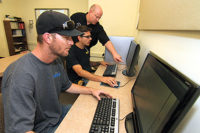The primary purpose of a sheet metal apprentice is to assist a sheet metal worker in the fabrication, assembly, installation, and repair of sheet metal equipment, products, and structures.
Apprentices at the Sheet Metal Workers Local No. 292 in Troy, Michigan, were asked to go beyond their typical job responsibilities when a large fire broke out at their building in August 2013.
The Roof is on Fire
According to reports, upon arrival at the scene, firefighters saw smoke coming from the roof of the large, two-story light industrial building. Firefighters took a hose line up to the second floor to try to locate and put out the fire but were forced to back out due to heavy smoke and heat, said Dave Roberts, Troy’s assistant fire chief, in a prepared statement.
The fire, which was believed to be sparked by faulty electrical wires, was eventually contained and extinguished after two ladder trucks used massive amounts of water to contain it to the front half of the building, where most of the office space was located. Everyone inside was safely evacuated and no one was injured, but the building was left with offices that were completely destroyed and a training center that was heavily damaged.
All equipment, furniture, and paper had to be quickly removed from the building, and the salvageable items had to be cleaned before returning back inside the facility. Once that strenuous process was completed, the eventual rebuild and renovation was ready to begin, but it would come at a high price.
The contents of what was lost totaled $70,000 for the training side and $50,000 for the union side. The rebuild and renovation of the building and training center was estimated to cost $1.5 million.
“Every tile, every light in the whole place had to be replaced,” said Kevin Stanbury, training director for the Sheet Metal Workers Local No. 292.
However, beyond the overwhelming financial burden, an unfortunate labor realization emerged as the fire stranded numerous apprentices who were in the middle of a four-year learning program. With the center obviously in no state for typical tutelage at the time, a distinctive solution came to pass: Apprentices at the Local No. 292 would take part in the rebuilding efforts.
A Unique Apprenticeship
The first word that came to mind for Stanbury when asked how the idea to have apprentices help rebuild the facility came about was necessity. “We wanted to keep costs down and still allow them to go through the program. That’s how all this spawned,” said Stanbury.
And, so, Stanbury’s idea became reality as he and his apprentices did a little bit of everything, from painting, welding booths, cleaning, and crafting shelves for the building.
The alternative to this unorthodox apprenticeship would have been to delay the learning process until the building was up and running once again, which was a move that everyone wanted to avoid.
There are more than 15,000 apprentices registered at the 153 training facilities in the U.S. and Canada, but few, if any, had experienced a scenario quite like this. Having the students participate in the rebuild sped up the learning process for some of the apprentices. In addition to refurbishing the training center, first-year apprentices, for example, relocated to another building to learn computer skills that are usually taught in the second or third years of the program.
“It was a very trying time, obviously,” said Stanbury. “We had no place to train and we had a training facility that was completely disheveled, but there was some kickback on it. There was good value added after the fact because it was a learning tool for everyone involved.”
“It was a group effort. Everyone’s opinion counted as to how everything was going to fit back together,” said Mark Graves, a first-year apprentice. “Instead of delaying it and letting us sit home for four or five months, they stepped us up until we could go back and continue with the program. I think they handled it very well.”
The group effort was overseen by Stanbury, but it was the apprentices themselves who were given leadership of the rebuild and renovation efforts. Stanbury served as the contractor, appointing different foremen on different days to give students individual opportunities to lead their peers.
“That part [allowing the apprentices to lead the rebuild efforts] was not unique to this project, that is just my leadership style,” said Stanbury. “I’ll usually find someone I consider to be management material, give him an assignment, and let him steerhead the project’s direction. They were in charge of everything, of course, with my supervision.
“There were a lot of things they were able to do they wouldn’t have had the opportunity to do otherwise,” Stanbury continued. “Every nut and bolt was gone. They had to redo everything. It was my vision to get it done, but they did the work. They realized the value we’ve added to the school, making it a better place to learn. These are some great workers who definitely learned a lot along the way.”
Local No. 292 Re-opens
“Three hundred and eighty days, 20 contractors, seven inspectors, 40 apprentices, countless hours of phone calls, 1,000-plus emails, 40 firefighters, approximately $500,000, and the best group of coworkers anyone could ever have,” posted Stanbury on the Sheet Metal Workers Local 292 Facebook page on Sept. 4, 2014. “That’s what it’s taken to rebuild our union hall. It’s not finished completely. There are a few lights, door handles, downspouts, and more to complete the project. However, we have a certificate of occupancy, and the union hall is officially open for business.”
The new training center was introduced to the community through an open house event on Nov. 21, 2014.
“The whole project turned out wonderful,” said Stanbury. “I’m really proud of everyone involved.”
For more information on Sheet Metal Workers Local No. 292, visit www.sheetmetal292.com.
Publication date: 1/12/2015
Want more HVAC industry news and information? Join The NEWS on Facebook, Twitter, and LinkedIn today!














